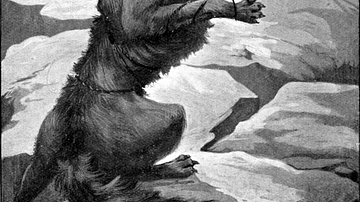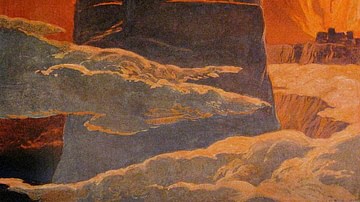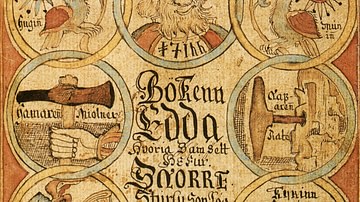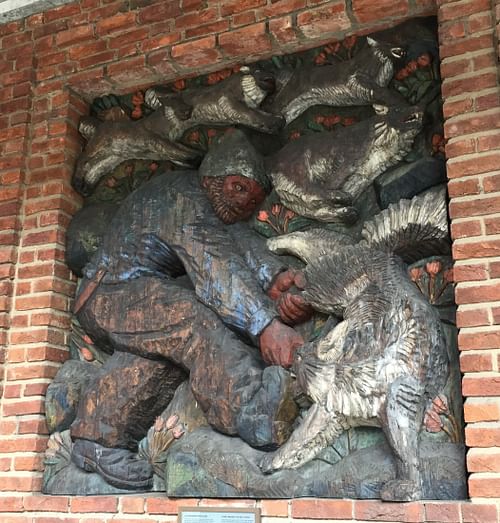
Vidar is a figure in Norse mythology, described as the silent god and almost as mighty as Thor. He will survive Ragnarök, the unavoidable and dramatic end of the world according to the prophecy that chief-god Odin extracts from a seeress, yet not without avenging his father first, Odin himself, by slaying Fenrir, the wolf who swallows him.
Sources
In Norse myth, despite the overwhelmingly present 'classical' gods, so to speak, such as Odin, Loki, Freyja, or Thor, made popular in the course of history by different works of art culminating with the entertainment industry of the 21 century, we also have a high number of characters of whom we know very little. There is a lot of speculation around these shadowy figures, but it is always best to stick to what the surviving sources have to tell and avoid fanciful interpretations. The main source, and an invaluable resource, remains the Poetic Edda, a collection of poems written down in Iceland in the 1200s but whose poems are dated back to the 900s given their archaic language features. The Prose Edda, written by Icelandic scholar and chieftain Snorri Sturluson, is more of a secondary source, although he most probably had access to more mythological material now unavailable to us.
Ragnarök
One of these lesser-known figures is Vidar (Old Norse: Víðarr, a word related to víðr – wide, a large warrior perhaps), a member of the Æsir family of gods, who would avenge his father Odin after he ends up swallowed by the wolf Fenrir in one of the titanic clashes of Ragnarök (destinies of the gods or twilight of the gods, depending on the spelling of the word). The wolf is described as so horrendously huge that it touches the skies with one jaw and the earth with the other. Odin, riding on his eight-legged horse Sleipnir and wielding his spear Gungnir that cannot miss, nevertheless fails to cheat fate.
The events are announced by apocalyptic roosters, after which the hellhound named Garm breaks loose (this could be the same character as Fenrir, although, in the Prose Edda, he has a different battle). The sun turns black, the god Heimdall, who watches over the realm of the gods, blows his horn to let the gods know of the doom. A great ship made out of the untrimmed nails of dead men will be launched from Jotunheim (Jǫtunheimr, the land of the giants) and commanded by Loki, followed by a terrible winter. There will be bloodshed among humans, leading to societies completely breaking down before the world of men sinks in the sea. The gods and giants will engage in tremendous duels on a mythical battle site (Vígríðr or Óskópnir), for example, Freyr will fight the fire-giant Surt, Thor will battle the world serpent Jörmungandr, and of course, Odin will face Fenrir. In this context, Vidar can fulfil the purpose for which he was born, to slay the wolf. These three duels are mentioned in all literary sources we have, while Snorri adds the one between Loki and Heimdall and the one between one-handed god Tyr and the hellhound Garm.
While it is not clear that Ragnarök is a cyclical event – it might just be a one-time rebirth, there are no clear hints these events will happen again – after the apocalypse, we have a series of gods who do return, who were either innocent or had little to do with the events preceding the twilight. The first category includes Baldr (also given as Baldur), described as the fairest and wisest, praised by everyone, killed by a twig of mistletoe, and his blind brother Hodr (Hǫðr), who slays him by accident after being tricked by Loki. The more archaic poems mention four sons of Odin: Baldur, Thor, Vidar, and Vali, while later sources vaguely suggest others as well, such as Hodr, Bragi or Heimdall, however, it is unclear whether "son" should be taken literally. The second category consists of Modi (Móði) and Magni, Thor's sons, as well as Vidar and Vali (Váli), the latter born with the sole purpose of avenging Baldr by slaying Hodr and binding Loki with the entrails of his son. To all these characters, we can add Hoenir (Hǿnir), another enigmatic figure who plays a part in giving life to the first human beings. Vidar and Vali will inhabit the place named Gimlé after Ragnarök.
Vidar vs. Fenrir
According to stanza 17 of the poem Grímnismál (The Lay of Grimnir), Vidar used to live in a realm with growing trees and high-standing grass generically called Vithi, with no further details other than the fact that he needs to leave in order to go slay Fenrir.
In his catalogue of the Æsir, the introduction Gylfaginning (The Deceiving of Gylvi), Snorri includes Vidar before Vali, mentioning the following: "Vidar is one called, the silent god. He has a thick shoe. He is strong, almost as strong as Thor. The gods place great trust in him in all struggles" (chapter 29). So Snorri classifies him as second best in might after Thor. The gods can always rely on him in all respects. In another passage, in chapter 51, one of the high-seated entities King Gilfi is talking to reveals details of the world's end. Among these, we are offered the information that his thick shoe would play an essential part in his act of vengeance because Vidar will set his foot covered in this great shoe on the bottom jaw of the wolf and rip it apart. The shoe was made out of various pieces people cut off when trimming their footwear, which is why it is important that they keep doing so.
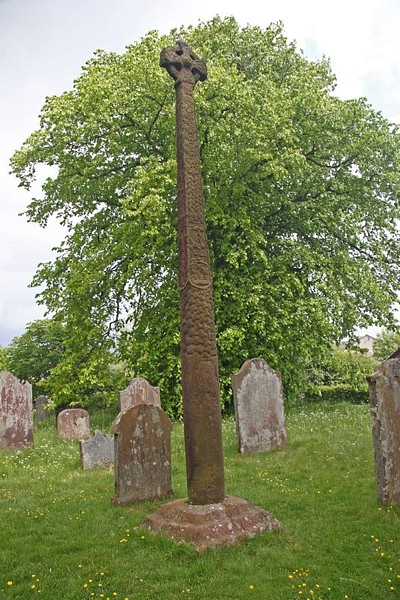
The intriguing artefact known as the Gosforth Cross from the early 10th century, standing in Cumbria, England, an area where the two cultures intersected, using Viking decorations and depicting scenes of both Norse and Christian influence, seems to confirm the circulation of this myth by showing a figure placing its foot in the mouth of a monstrous creature. Based on the information in the literary sources, we might decipher the curious imagery of the sandstone cross: on the west side, we see Loki bound in a cave with a serpent dripping venom on him, Heimdall the watchman of the gods holding his horn, while the scene with Vidar stands on the east side, together with the frame of a man stretching his arms with blood gushing, reminding of Christ or perhaps forcing an association between Christ and Baldur, the bright god mistakenly killed and who then descended into Hel(l). If we regard these images as a Christian missionary tactic of approaching the Norse by using double meanings, ideas from their own worldview, then Vidar slaughtering the wolf would remind of the victory of light and good over chaos and destruction.
The third poem of the Poetic Edda, the Vafþrúðnismál (The Lay of Vafthrudnir) tells us a similar story, which in a rough translation reads:
The wolf shall swallow
the father of men (Odin)
and Vidar will avenge that.
He will tear apart
those terrible jaws
and shall slay the wolf. (stanza 51)
The first poem in the collection, the Völuspá (The Prophecy of the Seeress), recounts a slightly different version in stanza 53 of the manuscript Codex Regius:
Then comes the Victory-Father‘s (Odin)
mighty son, Vidar,
to slay the slaughter-animal (wolf).
he will let the sword thrust
into the son of Loki
up to the heart,
then his father is avenged.
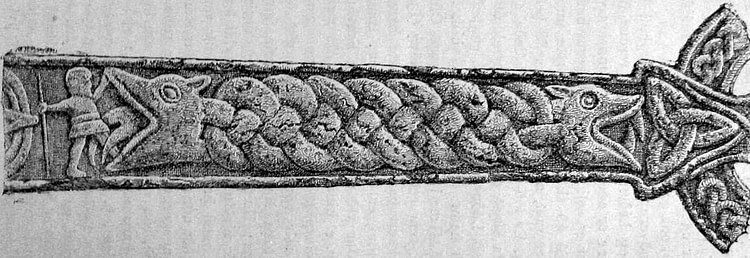
Other Mentions
Another reference to Vidar comes from the vigorous poem Lokasenna (Loki's Wrangling), a contest of insults very dear to the Norse spirit, encouraged by Loki's taunts at an assembly of gods and their ineffective replies to him. The poem's value is related to its rich content in mythological lore recorded nowhere else. After a failed attempt at removing Loki from the gathering, Odin spurs on Vidar, seated in his place, to make room for the father of the wolf (Loki). The silent god, although not suffering any insults directly, has no choice but to humbly serve him a drink, as according to the poem, he and Odin were curiously blood brothers and no ale could be poured unless it was meant for both of them.
In the second part of the Prose Edda, the guide book for future poets called Skáldskaparmál, we are told that we can use the following metaphors for Vidar: 'the silent god', 'the owner of the iron shoe', 'the enemy and slayer of Fenrir', 'the vengeance god of the gods', 'the son of Odin and the brother of the Æsir'. In his short story about Thor's journey to the giant Geirröd's realm after an agreement to redeem Loki's life, in the same source, we find the name of Vidar's mother, Grid (a gýgr, a giantess, troll-woman), who equips Thor with various items such as the belt of strength, iron glove, and her staff. Other than a very brief appearance in a list in chapter 75, the sources are silent about the silent god.



